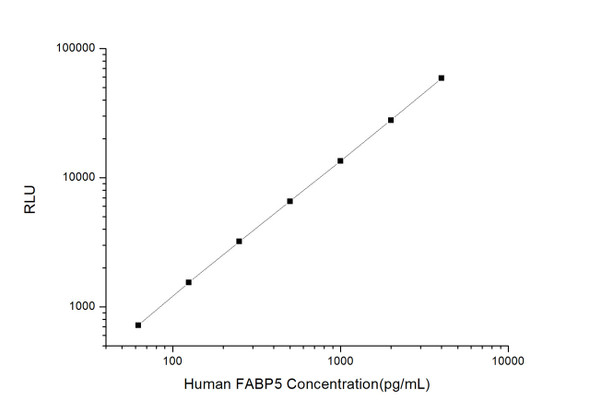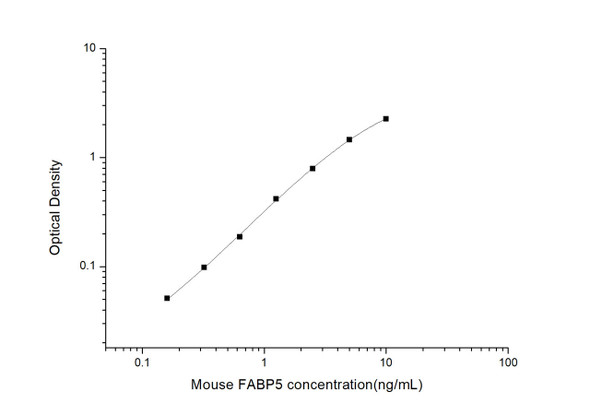Mouse Cell Signalling ELISA Kits 5
Mouse FABP5 (Fatty Acid Binding Protein 5, Epidermal) CLIA Kit (MOES00254)
- SKU:
- MOES00254
- Product Type:
- ELISA Kit
- ELISA Type:
- CLIA Kit
- Size:
- 96 Assays
- Sensitivity:
- 18.75pg/mL
- Range:
- 31.25-2000pg/mL
- ELISA Type:
- Sandwich
- Synonyms:
- E-FABP, EFABP, KFABP, PA-FABP, PAFABP
- Reactivity:
- Mouse
- Sample Type:
- Serum, plasma and other biological fluids
- Research Area:
- Signal Transduction
Description
| Assay type: | Sandwich |
| Format: | 96T |
| Assay time: | 4.5h |
| Reactivity: | Mouse |
| Detection method: | Chemiluminescence |
| Detection range: | 31.25-2000 pg/mL |
| Sensitivity: | 18.75 pg/mL |
| Sample volume: | 100µL |
| Sample type: | Serum, plasma and other biological fluids |
| Repeatability: | CV < 15% |
| Specificity: | This kit recognizes Mouse FABP5 in samples. No significant cross-reactivity or interference between Mouse FABP5 and analogues was observed. |
This kit uses Sandwich-CLIA as the method. The micro CLIA plate provided in this kit has been pre-coated with an antibody specific to Mouse FABP5. Standards or samples are added to the appropriate micro CLIA plate wells and combined with the specific antibody. Then a biotinylated detection antibody specific for Mouse FABP5 and Avidin-Horseradish Peroxidase (HRP) conjugate are added to each micro plate well successively and incubated. Free components are washed away. The substrate solution is added to each well. Only those wells that contain Mouse FABP5, biotinylated detection antibody and Avidin-HRP conjugate will appear fluorescence. The Relative light unit (RLU) value is measured spectrophotometrically by the Chemiluminescence immunoassay analyzer. The RLU value is positively associated with the concentration of Mouse FABP5. The concentration of Mouse FABP5 in the samples can be calculated by comparing the RLU of the samples to the standard curve.
| UniProt Protein Function: | FABP5: High specificity for fatty acids. Highest affinity for C18 chain length. Decreasing the chain length or introducing double bonds reduces the affinity. May be involved in keratinocyte differentiation. Belongs to the calycin superfamily. Fatty-acid binding protein (FABP) family. |
| UniProt Protein Details: | Protein type:Lipid-binding Cellular Component: cytoplasm Molecular Function:transporter activity; fatty acid binding; lipid binding Biological Process: transport; phosphatidylcholine biosynthetic process; glucose metabolic process; glucose transport; lipid metabolic process |
| NCBI Summary: | The protein encoded by this gene is part of the fatty acid binding protein family (FABP). FABPs are a family of small, highly conserved, cytoplasmic proteins that bind long-chain fatty acids and other hydrophobic ligands and participate in fatty acid uptake, transport, and metabolism. In humans this gene has been associated with psoriasis and type 2 diabetes. In mouse deficiency of this gene in combination with a deficiency in Fabp4 confers protection against atherosclerosis, diet-induced obesity, insulin resistance and experimental autoimmune encephalomyelitis (the mouse model for multiple sclerosis). Alternative splicing results in multiple transcript variants that encode different protein isoforms. The mouse genome contains many pseudogenes similar to this locus. [provided by RefSeq, Jan 2013] |
| UniProt Code: | Q05816 |
| NCBI GenInfo Identifier: | 462064 |
| NCBI Gene ID: | 16592 |
| NCBI Accession: | Q05816. 3 |
| UniProt Related Accession: | Q05816 |
| Molecular Weight: | 15,137 Da |
| NCBI Full Name: | Fatty acid-binding protein, epidermal |
| NCBI Synonym Full Names: | fatty acid binding protein 5, epidermal |
| NCBI Official Symbol: | Fabp5 |
| NCBI Official Synonym Symbols: | Klbp; mal1; Fabpe; E-FABP; PA-FABP |
| NCBI Protein Information: | fatty acid-binding protein, epidermal; uncharacterized protein LOC16592; keratinocyte lipid-binding protein; epithelial fatty acid-binding protein; epidermal-type fatty acid-binding protein; psoriasis-associated fatty acid-binding protein homolog |
| UniProt Protein Name: | Fatty acid-binding protein, epidermal |
| UniProt Synonym Protein Names: | Epidermal-type fatty acid-binding protein; E-FABP; Fatty acid-binding protein 5; Keratinocyte lipid-binding protein; Psoriasis-associated fatty acid-binding protein homolog; PA-FABP |
| Protein Family: | Fatty acid-binding protein |
| UniProt Gene Name: | Fabp5 |
| UniProt Entry Name: | FABP5_MOUSE |
As the RLU values of the standard curve may vary according to the conditions of the actual assay performance (e. g. operator, pipetting technique, washing technique or temperature effects), the operator should establish a standard curve for each test. Typical standard curve and data is provided below for reference only.
| Concentration (pg/mL) | RLU | Average | Corrected |
| 2000 | 50896 60546 | 55721 | 55693 |
| 1000 | 22268 25680 | 23974 | 23946 |
| 500 | 11554 10510 | 11032 | 11004 |
| 250 | 4993 5595 | 5294 | 5266 |
| 125 | 2759 2457 | 2608 | 2580 |
| 62.5 | 1332 1290 | 1311 | 1283 |
| 31.25 | 661 687 | 674 | 646 |
| 0 | 27 29 | 28 | -- |
Precision
Intra-assay Precision (Precision within an assay): 3 samples with low, mid range and high level Mouse FABP5 were tested 20 times on one plate, respectively.
Inter-assay Precision (Precision between assays): 3 samples with low, mid range and high level Mouse FABP5 were tested on 3 different plates, 20 replicates in each plate.
| Intra-assay Precision | Inter-assay Precision | |||||
| Sample | 1 | 2 | 3 | 1 | 2 | 3 |
| n | 20 | 20 | 20 | 20 | 20 | 20 |
| Mean (pg/mL) | 109.61 | 288.63 | 734.19 | 108.87 | 300.01 | 669.32 |
| Standard deviation | 14.22 | 21.36 | 71.88 | 13.50 | 27.60 | 62.72 |
| C V (%) | 12.97 | 7.40 | 9.79 | 12.40 | 9.20 | 9.37 |
Recovery
The recovery of Mouse FABP5 spiked at three different levels in samples throughout the range of the assay was evaluated in various matrices.
| Sample Type | Range (%) | Average Recovery (%) |
| Serum (n=5) | 91-106 | 97 |
| EDTA plasma (n=5) | 95-106 | 100 |
| Cell culture media (n=5) | 91-103 | 98 |
Linearity
Samples were spiked with high concentrations of Mouse FABP5 and diluted with Reference Standard & Sample Diluent to produce samples with values within the range of the assay.
| Serum (n=5) | EDTA plasma (n=5) | Cell culture media (n=5) | ||
| 1:2 | Range (%) | 100-114 | 90-104 | 96-110 |
| Average (%) | 108 | 96 | 104 | |
| 1:4 | Range (%) | 88-99 | 100-119 | 99-113 |
| Average (%) | 94 | 109 | 107 | |
| 1:8 | Range (%) | 90-103 | 96-106 | 87-98 |
| Average (%) | 97 | 101 | 93 | |
| 1:16 | Range (%) | 92-104 | 83-97 | 94-107 |
| Average (%) | 99 | 90 | 99 |
An unopened kit can be stored at 4°C for 1 month. If the kit is not used within 1 month, store the items separately according to the following conditions once the kit is received.
| Item | Specifications | Storage |
| Micro CLIA Plate(Dismountable) | 8 wells ×12 strips | -20°C, 6 months |
| Reference Standard | 2 vials | |
| Concentrated Biotinylated Detection Ab (100×) | 1 vial, 120 µL | |
| Concentrated HRP Conjugate (100×) | 1 vial, 120 µL | -20°C(shading light), 6 months |
| Reference Standard & Sample Diluent | 1 vial, 20 mL | 4°C, 6 months |
| Biotinylated Detection Ab Diluent | 1 vial, 14 mL | |
| HRP Conjugate Diluent | 1 vial, 14 mL | |
| Concentrated Wash Buffer (25×) | 1 vial, 30 mL | |
| Substrate Reagent A | 1 vial, 5 mL | 4°C (shading light) |
| Substrate Reagent B | 1 vial, 5 mL | 4°C (shading light) |
| Plate Sealer | 5 pieces | |
| Product Description | 1 copy | |
| Certificate of Analysis | 1 copy |
- Set standard, test sample and control (zero) wells on the pre-coated plate and record theirpositions. It is recommended to measure each standard and sample in duplicate. Note: addall solutions to the bottom of the plate wells while avoiding contact with the well walls. Ensuresolutions do not foam when adding to the wells.
- Aliquot 100µl of standard solutions into the standard wells.
- Add 100µl of Sample / Standard dilution buffer into the control (zero) well.
- Add 100µl of properly diluted sample (serum, plasma, tissue homogenates and otherbiological fluids. ) into test sample wells.
- Cover the plate with the sealer provided in the kit and incubate for 90 min at 37°C.
- Aspirate the liquid from each well, do not wash. Immediately add 100µL of BiotinylatedDetection Ab working solution to each well. Cover the plate with a plate seal and gently mix. Incubate for 1 hour at 37°C.
- Aspirate or decant the solution from the plate and add 350µL of wash buffer to each welland incubate for 1-2 minutes at room temperature. Aspirate the solution from each well andclap the plate on absorbent filter paper to dry. Repeat this process 3 times. Note: a microplatewasher can be used in this step and other wash steps.
- Add 100µL of HRP Conjugate working solution to each well. Cover with a plate seal andincubate for 30 min at 37°C.
- Aspirate or decant the solution from each well. Repeat the wash process for five times asconducted in step 7.
- Add 100µL of Substrate mixture solution to each well. Cover with a new plate seal andincubate for no more than 5 min at 37°C. Protect the plate from light.
- Determine the RLU value of each well immediately.






